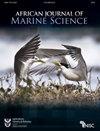The influence of estuary eutrophication on the benthic diatom community: a molecular approach
IF 1.4
4区 生物学
Q3 MARINE & FRESHWATER BIOLOGY
引用次数: 3
Abstract
The occurrence of harmful algal blooms (HABs) is increasing in frequency and intensity in South African estuaries because of eutrophication. This study used DNA metabarcoding to identify the benthic diatom community structure in the eutrophic Sundays Estuary. The recurrent HAB phytoplankton species Heterosigma akashiwo was recorded at bloom concentrations (∼100 µg Chl a l−1) in the brackish, vertically stratified middle reaches of the estuary. In contrast, microphytobenthos biomass increased towards the upper reaches in response to elevated availability of total oxidised nitrogen (NOx) and increased sediment stability. A total of 76 diatom species were identified using the molecular technique. Seven known nutrient-tolerant diatom species indicate a preference for either ammonium or NOx enrichment. Benthic diatom community diversity (H′ < 1) and evenness (J′ < 0.25) were low in the brackish middle reaches of the estuary, where the HABs decreased available light. Heterosigma akashiwo has been found in previous studies to suppress the growth of co-occurring taxa. Future research efforts should focus on verifying this relationship over seasonal timescales given the dominance of H. akashiwo in spring/summer. As the persistently nutrient-enriched state and stable flow conditions of the Sundays Estuary is the key driver of change, management efforts should be geared towards re-establishing the estuary’s natural flow variations and to measures that can mitigate nutrient pollution.河口富营养化对底栖硅藻群落的影响:分子方法
由于富营养化,南非河口有害藻华的发生频率和强度都在增加。本研究利用DNA代谢编码技术对富营养化Sundays河口的底栖硅藻群落结构进行了鉴定。在河口半咸水、垂直分层的中游地区,记录到赤潮浓度为(~100µg Chl a l−1)的赤潮浮游植物物种Heterosigma akashiwo。相比之下,由于总氧化氮(NOx)的可用性提高和沉积物稳定性增加,向上游方向的微型底栖生物生物生物量增加。利用分子技术共鉴定出76种硅藻。七种已知的耐营养硅藻物种表明它们更喜欢富集铵或NOx。河口半咸水中游底栖硅藻群落多样性(H′<1)和均匀度(J′<0.025)较低,赤潮降低了可用光。在以前的研究中已经发现赤尾异西格玛可以抑制共存类群的生长。鉴于H.akashiwo在春季/夏季占主导地位,未来的研究工作应侧重于在季节性时间尺度上验证这种关系。由于Sundays河口持续的营养丰富状态和稳定的水流条件是变化的关键驱动力,管理工作应致力于重建河口的自然流量变化,并采取措施减轻营养污染。
本文章由计算机程序翻译,如有差异,请以英文原文为准。
求助全文
约1分钟内获得全文
求助全文
来源期刊

African Journal of Marine Science
生物-海洋与淡水生物学
CiteScore
2.60
自引率
16.70%
发文量
17
审稿时长
6-12 weeks
期刊介绍:
The African (formerly South African) Journal of Marine Science provides an international forum for the publication of original scientific contributions or critical reviews, involving oceanic, shelf or estuarine waters, inclusive of oceanography, studies of organisms and their habitats, and aquaculture. Papers on the conservation and management of living resources, relevant social science and governance, or new techniques, are all welcomed, as are those that integrate different disciplines. Priority will be given to rigorous, question-driven research, rather than descriptive research. Contributions from African waters, including the Southern Ocean, are particularly encouraged, although not to the exclusion of those from elsewhere that have relevance to the African context. Submissions may take the form of a paper or a short communication. The journal aims to achieve a balanced representation of subject areas but also publishes proceedings of symposia in dedicated issues, as well as guest-edited suites on thematic topics in regular issues.
 求助内容:
求助内容: 应助结果提醒方式:
应助结果提醒方式:


